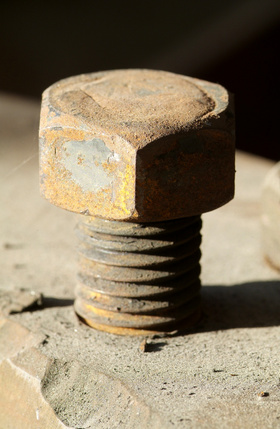
When a bolt snaps while you're working, it’s more than a source of frustration: It’s also a delay in finishing the job or project. Quick extraction of the broken shaft is the best way to get back to work. If you’re lucky, the bolt will yield to a generous application of penetrating lubricant and a pair of locking pliers. If you’re not lucky, however, you will probably end up drilling out the offending bolt. Only in a worst-case scenario will you be forced to retap the bolt hole.
Grind the head of the broken shaft smooth with an electric or air-powered grinder. This helps prevent the drill from slipping. When you have finished grinding, apply a generous amount of penetrating lubricant.
Punch an impression at the center of the bolt with a hammer and metal punch. Drill a pilot hole as straight as possible into the center of the bolt using a 1/8-inch bit (smaller for small-diameter bolts).
Switch the drill to "Reverse" and load with a left-handed drill bit 3/16 or 1/8 inch smaller than the diameter of the stuck bolt. Drill straight down the pilot hole with the left-handed bit to keep from accidentally cutting into the metal surrounding the threads.
Allow the left-handed bit to loosen the bolt on its own. Repeat the process with increasingly larger left-handed bits until the bolt comes free. Once the bolt is free, lubricate the bolt hole and clean out any rust. You can then use another bolt of the same size and thread count as the original without modification.
Grind the head of the broken shaft smooth with a grinder to help keep the drill from slipping. When grinding is finished, apply a liberal amount of penetrating lubricant.
Punch an impression at the center of the bolt with a hammer and metal punch. Drill a pilot hole as straight as possible into the center of the bolt using a 1/8-inch bit (smaller for small-diameter bolts).
Choose a drill bit that is slightly larger than the diameter of the original bolt, including threads. Drill straight down the center of the bolt, following the pilot hole, to the full depth.
Insert a HeliCoil or other type of thread-repair kit, following the package instructions. This will allow you to use a bolt of the same size as the original.
Choose a tap to match the diameter of the new hole. Select a tap with thread count the same as or similar to that of the original bolt.
Mount the tap in its wrench or handle. Apply lubricating oil to the hole and insert the tap.
Straighten the tap in the hole and start it turning clockwise. The axis of the tap must be the same as that of the pilot hole.
Remove the tap after a few turns. Blow or brush out the metal shavings created by the cutting action.
Reinsert the tap and continue turning it until the hole is tapped to its required depth, keeping the hole clean and lubricated throughout the process. Clean the bolt hole of shavings and lubricant before inserting the bolt to test the hole.